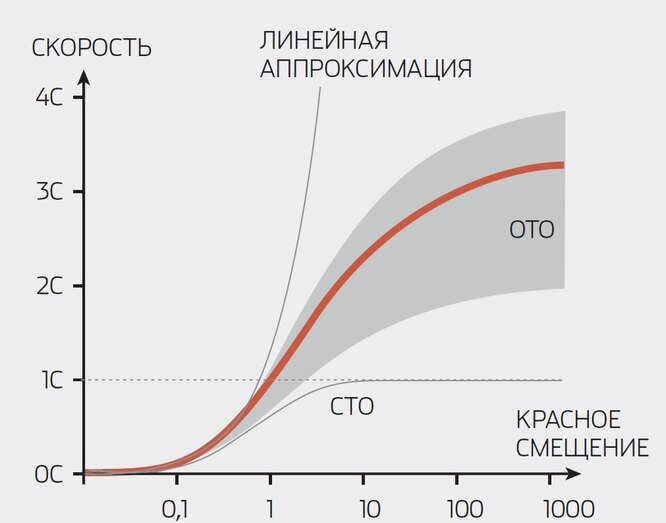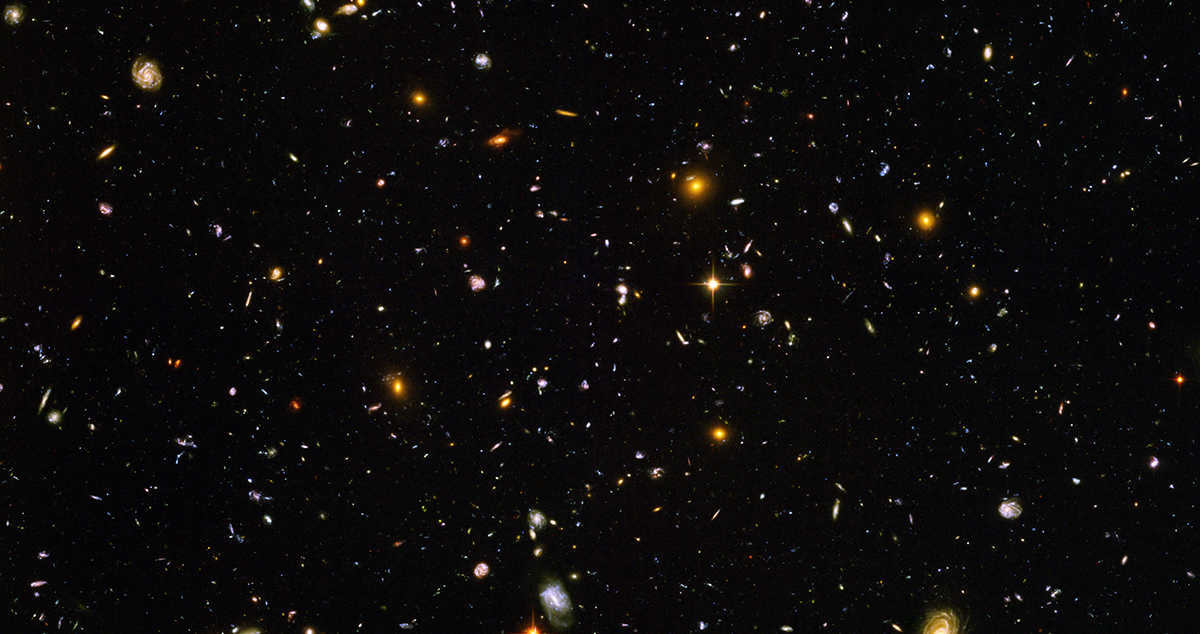
The phenomenon of the universe expanding is something that can be observed, as the distances between galaxies and other celestial objects are getting larger as time goes on. This discovery completely changed the way we understand the universe and has become a fundamental idea in modern cosmology. The idea of a universe that is expanding is closely connected to the Big Bang theory, which states that the universe came into existence about 13.8 billion years ago from a state that was incredibly dense and hot.
Historical context
The concept of a universe that is constantly expanding first arose during the early 1900s as scientists delved into the study of galaxy distribution and motion. In 1912, a significant breakthrough was made by American astronomer Vesto Melvin Slifer, who observed a phenomenon that would pave the way for future scientific advancements. Slifer conducted measurements of the redshifts of numerous galaxies and discovered that the majority of them displayed a Doppler shift towards longer wavelengths, indicating their increasing distance from Earth.
Expanding upon Slifer’s findings, Georges Lemaître, a Belgian astronomer, proposed in 1927 that the universe was undergoing expansion. Nevertheless, it wasn’t until 1929 when Edwin Hubble, an American astronomer, presented compelling observational proof in support of this theory. Hubble’s examination of distant galaxies revealed a connection between their redshift and their relative distance, which is now recognized as Hubble’s law. This relationship demonstrates that as a galaxy recedes further from our location, it also accelerates its movement away from us.
The development of the Big Bang theory was a result of the discovery of an expanding universe. This theory suggests that the universe originated from a highly dense and hot state known as a singularity. According to this concept, all matter, energy, space, and time came into existence simultaneously, giving birth to our Universe.
The expansion of the Universe can be visualized as a stretching of space itself, causing galaxies and other cosmic structures to move apart. It is important to note that this expansion does not occur within the confines of space, but rather affects the very fabric of space itself. To illustrate this concept, one can imagine the inflation of a balloon, where the surface of the balloon represents the universe. As the balloon expands, all points on its surface move away from each other.
Evidence supporting the expansion of the universe
Over time, a substantial amount of evidence has emerged to support the concept of a universe that is continuously expanding. One particularly convincing piece of evidence is the observation of the cosmic microwave background radiation (CMB). This faint glow of radiation is present throughout the entire universe and is believed to be residual heat from the early stages of the Big Bang. The CMB’s homogeneity and isotropy strongly suggest that there was a uniformly distributed, expanding universe in its early stages.
Additionally, the abundance of light elements such as hydrogen and helium in the universe serves as another crucial piece of evidence. The predictions made by the Big Bang theory accurately align with the observed ratio of these elements, which formed within the first few minutes after the initial expansion.
Additional evidence for the expansion of the Universe
Furthermore, the vast structure of the Universe provides additional proof of its expansion. The presence of galaxy clusters, filaments, and voids suggests the existence of a complex network-like formation that was created through gravitational interactions spanning billions of years.
Rate of expansion and the enigma of dark energy
The rate of expansion of the universe is measured by the Hubble constant, represented by H. This constant represents the current speed at which galaxies are moving apart from each other. Determining the precise value of the Hubble constant has been the focus of intense research and debate within the scientific community. Different methods of measurement, such as observing supernovae or studying CMBs, yield slightly different outcomes, leading to a continuous pursuit of the utmost precision in these measurements.
Furthermore, there have been recent findings indicating that the Universe is experiencing a rapid increase in its expansion. This groundbreaking discovery, which was made in the late 1990s, was recognized and awarded the Nobel Prize in Physics in 2011. The cause behind this accelerated expansion is believed to be a perplexing force known as dark energy, which is estimated to make up around 68% of the overall energy composition of the universe. The precise characteristics and properties of dark energy continue to be the focal point of ongoing scientific investigations.
The future of the Universe
According to current theories, the Universe will continue expanding indefinitely. However, the rate of expansion and the ultimate destiny of the cosmos depend on the interplay between the amount of matter and energy present, as well as the nature of dark energy. Depending on these variables, the Universe could undergo a phenomenon known as the “Big Bang,” in which the expansion accelerates to the point where galaxies, stars, and even atoms are torn apart.
Alternatively, if dark energy diminishes or undergoes changes over time, the expansion could slow down, leading to a scenario referred to as the “Big Freeze.” In this scenario, the Universe would gradually grow colder and less dense as stars exhaust their fuel and galaxies become increasingly isolated.

The expansion of our universe is occurring at an increasingly rapid pace. With each passing moment, the distance between cosmic galaxies is growing at an accelerated rate.
What lies in store for the ultimate destiny of the universe? Will it continue its eternal expansion or will it eventually collapse? The key to understanding this lies in unraveling the enigma known as “dark energy,” which is the driving force behind the sudden acceleration that began approximately 4-5 billion years ago.
It was not until the latter half of the 20th century that scientists made the groundbreaking discovery that the universe is expanding at an accelerating rate. This revelation occurred roughly 5 billion years ago, a relatively short period of time in relation to the universe’s age of nearly 14 billion years. This finding was highly unexpected and defied the prevailing theories of the time, which predicted that the universe should be gradually slowing down its expansion, rather than speeding up.
Interestingly, Einstein himself faced difficulties when confronted with the concept of a dynamic rather than stagnant universe. The renowned scientist maintained a belief that, almost until the end of his life, the universe should remain static and unchanging, devoid of expansion or contraction. In order to reconcile this belief with the contrary evidence provided by his equations, he introduced the cosmological constant, which serves to impede the expansion of space.
In 1929, American astronomer Edwin Hubble made a groundbreaking discovery known as the redshift of galaxies. This revelation brought to light the observation that all other galaxies in the cosmos appear to be “receding” from us.
Similar to how the sound of a car alters as it approaches us, the “color” of a galaxy shifts when it moves, allowing us to discern whether it is approaching or moving away from Earth.
Hubble’s observation of galaxies shifting into the red spectrum in visible light indicates that these objects are moving away from us, allowing us to measure their speed. This phenomenon, known as Hubble’s law, has led to the discovery of Hubble’s constant, which represents the rate of expansion (currently estimated at about 72 kilometers per second per megaparsec). To put this into perspective, 1 parsec is equivalent to 31 trillion kilometers or 206,265 times the distance between the Earth and the Sun, and 1 megaparsec is equal to 1 million parsecs.
Therefore, the only logical explanation is that the universe’s space is expanding and cannot be static. Hubble’s empirical experiments provided evidence for this, but the concept was also mathematically stated earlier by Belgian mathematician Georges Lommer in 1927. Faced with this evidence, even Einstein himself abandoned the cosmological constant and referred to it as “the biggest mistake of his career”.
However, in today’s world, it is rather surprising that we find ourselves in need of the cosmological constant once again, albeit in a slightly altered manner.
The theory of the big bang and the progression of the universe
When it becomes apparent that galaxies are moving away from each other, it is only logical to deduce that they were all once clustered together at the initial stage. Furthermore, we can hypothesize that at the very inception, the entire universe was condensed into a single point of explosion. Hence, the theory of the big bang comes into existence.
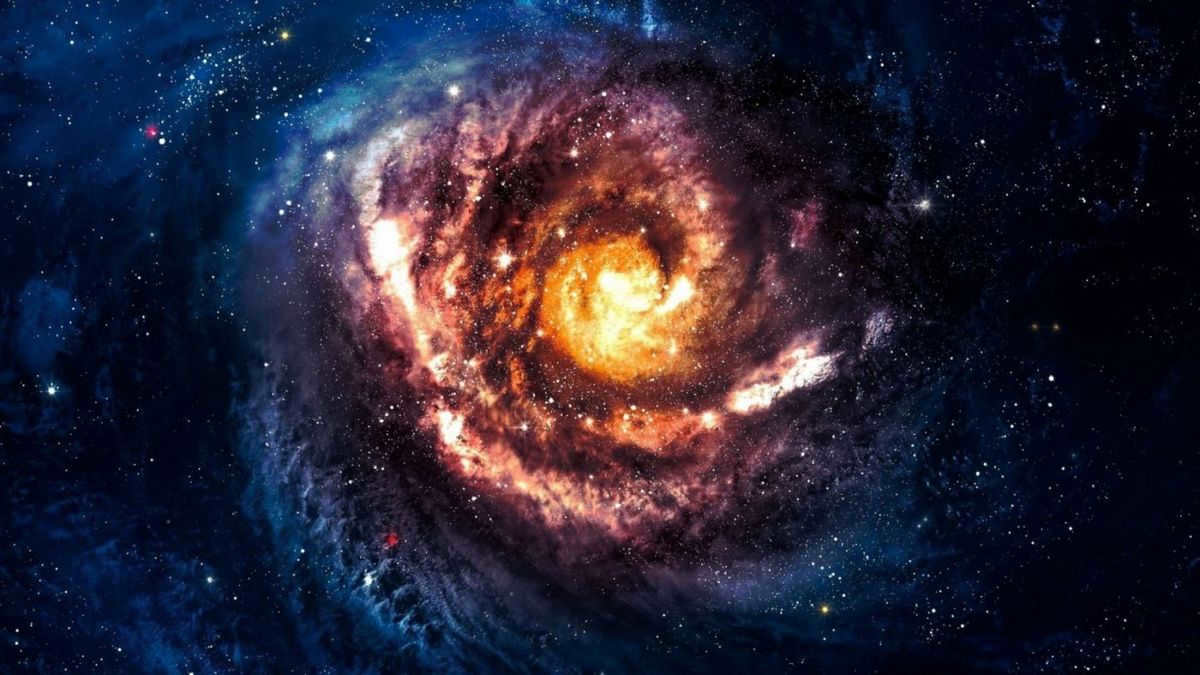
Nowadays, it is widely acknowledged and extensively tested that the expansion of the universe is one of the most prominent theories. The reason behind its widespread acceptance lies in its remarkable explanatory capabilities. In fact, if everything was once condensed into a single point, that particular state must have had an immense temperature and an extraordinary density. Replicating such extreme conditions is a key objective of contemporary particle accelerators, such as the Large Hadron Collider at CERN. Additionally, the explanation of the formation of chemical elements through the process of the Big Bang, known as Primordial Nucleosynthesis, stands as one of the significant achievements in theoretical nuclear physics.
It is known as cosmic microwave background radiation or relict radiation. The concept is that in the early stages of the universe, it was a highly dense and hot plasma and therefore, opaque. As the universe expanded, its temperature decreased and it began to cool. At a lower temperature, stable atoms formed, but they could not absorb heat, causing the universe to become transparent (approximately 300-400 years after the Big Bang). This is when the first photons were emitted, which still exist in space and are detectable by us. Hence, this radiation is referred to as relict radiation or residual radiation. This moment also represents the farthest observable point with our telescopes.
In 1964, the relic background effect was experimentally discovered by Arno Penzias and Robert Wilson, who were radio astronomers. They detected a constant microwave “noise” with a temperature of approximately 2.7 Kelvin, which was found to be evenly distributed throughout the sky, unrelated to any specific star or object. This phenomenon is considered to be the echo of the cosmic birth, resulting from the explosive event that initiated our universe. The discovery of this relic background effect serves as undeniable evidence supporting the Big Bang theory, and as a result, Penzias and Wilson were awarded the Nobel Prize in 1978.
The phenomenon of cosmic microwave background radiation
In addition to providing undeniable evidence for the Big Bang theory, relic radiation has also revealed another fascinating discovery. The Wilkinson Microwave Anisotropy Probe (WMAP), which was deployed in 2001, has successfully mapped the cosmic background radiation across the observable Universe. By analyzing the color variations in the radiation pattern, scientists have identified small temperature discrepancies. Remarkably, the radiation exhibits a remarkable level of homogeneity, accurate to five decimal places. However, beyond this level of precision lies an intriguing and unexpected revelation – the presence of dark matter.
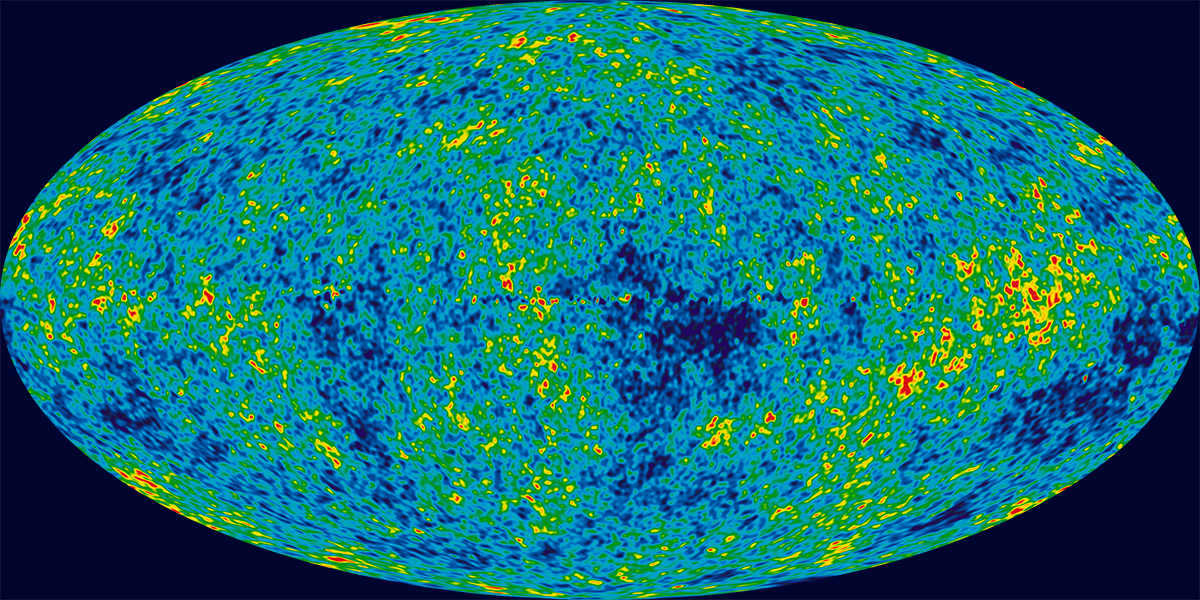
Dark matter, which can only be detected through its gravitational interaction, remains unobservable by any other means. It is estimated to make up around 25 percent of the total density of the universe, while ordinary matter, like ours, accounts for only 4-5 percent.
Fritz Zwicky first proposed the existence of dark matter in 1934 to explain the “Missing Mass Problem.” This problem arose because galaxies are unable to remain stable and rotate as they do unless there is a significant amount of hidden mass that holds the stars within a galaxy together. The presence of large amounts of dark matter is clearly confirmed by the results of cosmic background radiation.
The WMAP results can also be utilized to determine the geometry of the universe, whether it is closed, open, or flat.
Presently, our understanding is that the cosmos is flat with an accuracy of 0.5 percent. This is promising, but it also implies that the ultimate fate of space evolution can vary based on the density of matter and energy in the universe. If the total density, also known as the Omega cosmological parameter, surpasses a critical mass, the universe has the potential to contract in a phenomenon referred to as the Big Crash, which stands in stark contrast to the renowned big bang. Alternatively, we could experience infinite expansion until the universe itself becomes incredibly frigid, desolate, and relatively unremarkable. This concept is known as the Big Cooling theory.
In reality, how can we determine the events that have occurred in the vast expanse of the universe, as well as predict its future? Due to the finite nature of the speed of light, the further an object is from us, the longer it will take for its light to reach our eyes. For instance, it takes approximately 8 minutes for light from the Sun to travel to Earth. By utilizing telescopes to observe distant stars, we are essentially glimpsing into the past, as we are viewing light that was emitted from these stars many years ago and has only now reached us. Consequently, if we are able to compare two identical objects that are situated at various distances, we can infer the changes in the space between them over a given period of time.
Objects that exist in relatively similar locations in space are commonly referred to as standard candles.
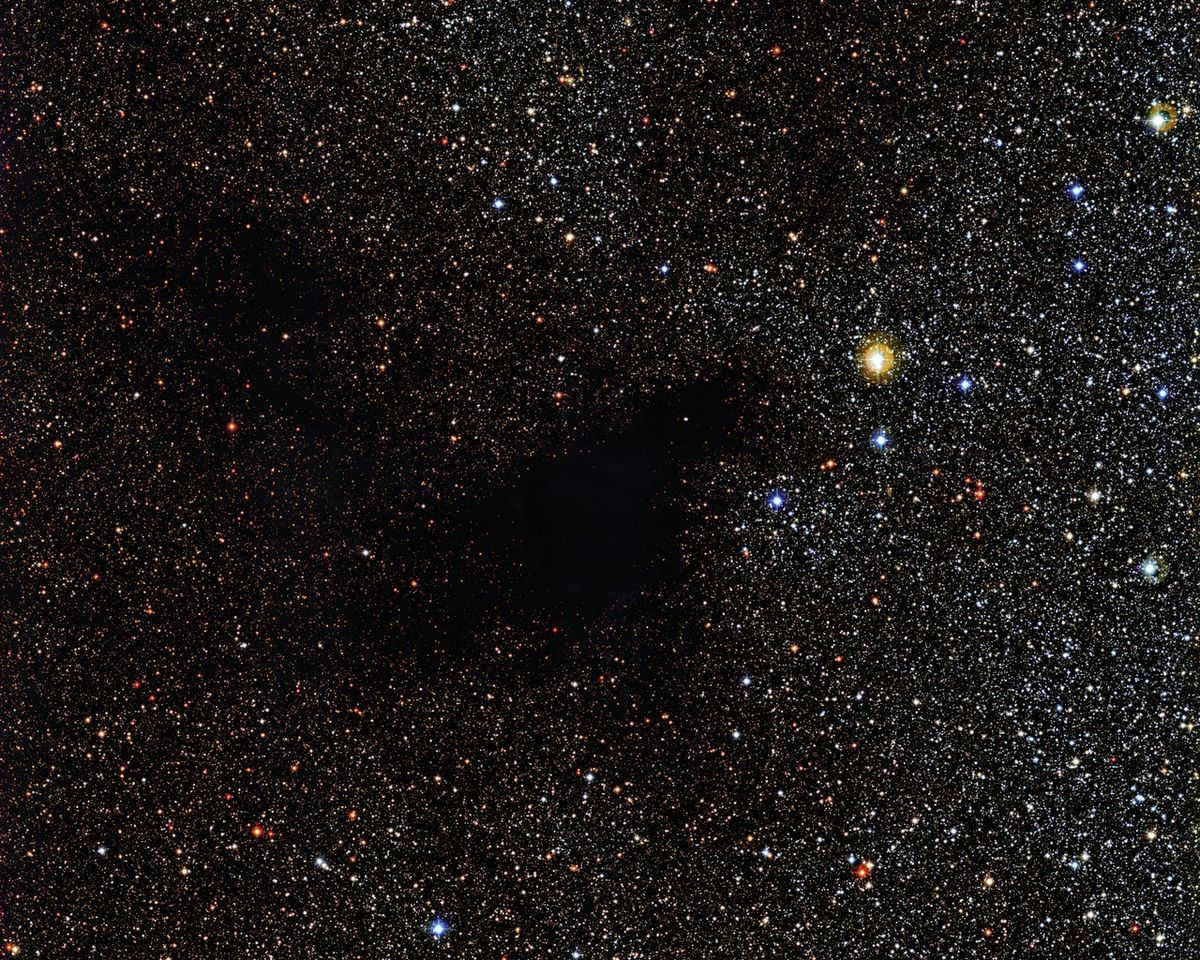
These may be variable stars of a unique kind called Cepheids. They pulsate in the same manner, meaning they emit the same amount of light at regular intervals. Another group of objects that serve as even more precise distance indicators are supernovae of the IA type. These supernovae occur due to the thermonuclear collapse of a star, or actually a binary star system. Since the process is consistent, the same amount of energy is always released. This is why IA supernovae are considered our most reliable standard candles.
Significantly, in 1997, research on supernovae revealed the remarkable finding that the universe is actually undergoing a rapid expansion. This expansion is not due to any change in the energy of the flashes observed, but rather is solely a result of the dynamics of space. By studying these flashes, scientists are able to construct a timeline of the evolution of space over time. Interestingly, it has been discovered that for the first 8-9 billion years after the initial explosion, the universe actually slows down, as one would expect. However, at a certain point, the expansion suddenly accelerates!
This acceleration presents a major paradox, as the cause of this rapid expansion is still unknown. In order to explain this phenomenon, scientists have reintroduced Einstein’s cosmological constant into the equations, but with a twist – it has the opposite sign, acting like antigravity and causing space to rapidly expand.
Surprisingly, it appears that Einstein may not have been completely off the mark.
Currently, we have knowledge that approximately 70 percent of the total energy density of the universe is occupied by dark energy. The origins and true nature of dark energy remain unknown to us. It is possible that the strength of dark energy may either decrease or increase as time progresses.
These possibilities lead to two potential scenarios for the ultimate fate of our universe. If the cosmological constant continues to operate and strengthen, then we will experience eternal expansion. Conversely, if the force of dark energy weakens and gravity prevails, then our cosmos may face the Great Fall. In such a scenario, it is conceivable that a new universe could be birthed in a cosmic Big Bang event. However, at present, these concepts remain enigmatic, awaiting the forthcoming revelation of answers.
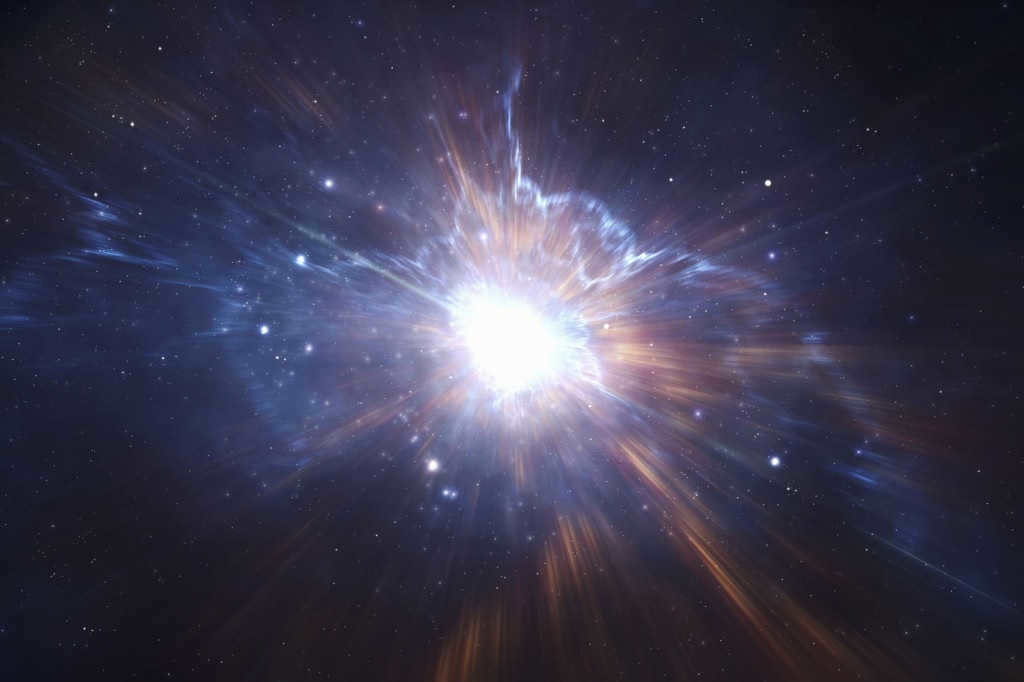
The main topic of this article concerns the erroneous interpretation made by astronomers regarding the redshift observed in distant galaxies. They have wrongly attributed this redshift solely to the speed at which these galaxies are moving away from us. This flawed assumption has formed the basis for the theory of the expansion of the universe, including the idea of its acceleration. Unfortunately, astronomers have overlooked other potential causes for the redshift, which I will explain below.
In 1929, the astronomer Hubble made a significant discovery. He observed that the redshift of space objects increases as their distance from us increases. Based on this observation, he mistakenly concluded that our universe is expanding. This conclusion became known as Hubble’s Law.
In Hubble’s Law:
- V represents the velocity at which an object is moving away from us.
- H0 is Hubble’s constant.
- R is the distance to the object.
The universe refers to that portion of space from which we can observe, perceive, and receive signals.
If an explosion occurs, would the same particles expand at an increased rate? It is unlikely, as in explosions, fragments disperse at different velocities. The fastest fragments are located on the outer edge and travel further away from us. Thus, the outer edge always exhibits the highest speed. Conversely, the fragments nearer to the center move at a slower pace and remain closer to us. This pattern persists if there is no mutual attraction. However, there is no acceleration involved. Instead, there is a maximum speed, which is found at the outer edge. This maximum speed remains constant. There is no expansion of space, and matter does not appear out of nowhere. Therefore, the notion of accelerated expansion is propagated by individuals with limited knowledge of explosions.
However, the concept of a universe that is constantly growing goes against the principle of homogeneity. This is because if there is an empty space in one part of the universe, matter from other regions would immediately rush in to fill it, similar to how a low-pressure area is filled. Nonetheless, this argument is not very strong as there are bound to be some inconsistencies. However, these inconsistencies would not be as prevalent. Additionally, if the universe is expanding, why aren’t there other universes that are also expanding?
Therefore, in line with Hubble’s assertion of an expanding universe, scientists started to develop an explanation for the existence of dark matter. They also hypothesized that matter itself could emerge from nothingness, from the void, in order to maintain the density of the universe. Otherwise, the principle of homogeneity would no longer hold true. Now, let’s examine why the statement about the expansion of the Universe is inaccurate.
Measuring speed using the Doppler shift phenomenon
When we observe the movement of objects in the absence of significant gravitational forces, the rate at which they approach or move away from us can be determined by analyzing the Doppler shift. This principle forms the foundation of speed measuring radars.
Hubble’s groundbreaking discovery revealed that the degree of redshift observed in the radiation emitted by galaxies is directly proportional to their distance from our location.
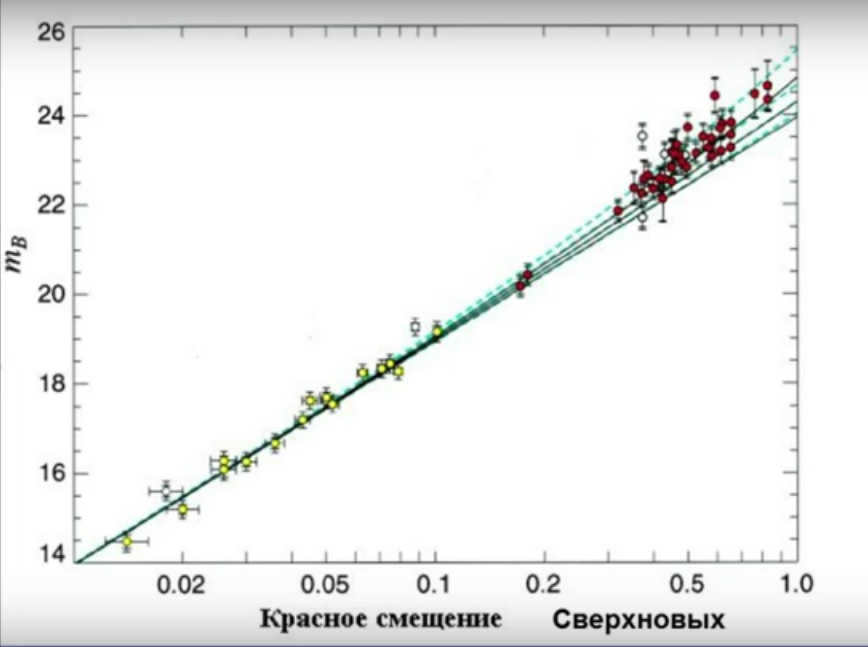
The bright stars of galaxies are represented by the vertical line on the graph, with its size increasing as they get farther away. On the other hand, the horizontal line represents displacement on a logarithmic scale, which is denoted by Δ λ/λ.
However, why did Hubble specifically attribute the redshift solely to the Doppler effect? It is this erroneous assertion that is connected to the biggest falsification in the field of astronomy concerning the expansion of the universe.
The impact of gravity on the phenomenon of redshift
Have you ever wondered what occurs to light when it encounters a powerful gravitational field? As per Einstein’s theories, light undergoes deflection when it traverses near massive entities.
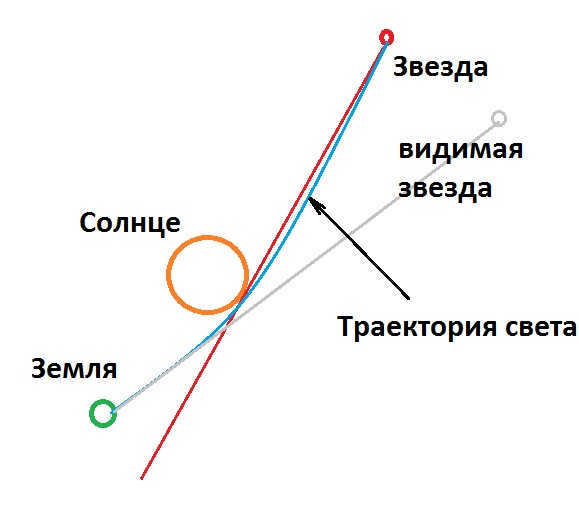
When sunlight passes near the sun, it becomes bent, causing us to perceive the star in a different location than it actually is.
Gravity-induced Redshift
So, what happens to light when it escapes from a massive object? When gravity opposes the direction of the light’s radiation, a similar effect occurs. Gravity influences the light and drains some of its energy. The energy of a photon is proportional to its frequency.
As the energy decreases, the light undergoes a Doppler shift towards the red and infrared regions, resulting in a decrease in frequency (increase in wavelength). This is because the more energy a photon loses to gravity, the lower its frequency becomes. As a result, the larger the mass of the star, the greater the redshift.
Therefore, the red shift of the spectrum is caused by both gravitational effects and the removal of objects. However, gravitational effects always result in a shift, while removal only accounts for 50% of the shift. The greatest shift occurs when the velocity vector is directed straight away from us.
Redshift resulting from the presence of massive galaxies
Additionally, the redshift of a photon is influenced by the presence of massive galaxies located behind the observed star and in close proximity to it. Conversely, the blue shift is influenced by galaxies located beyond Earth. Calculating this influence is extremely challenging, but it is undoubtedly present. It is doubtful that anyone has taken this into account. What if there is a black hole behind the star? The contribution of these massive objects to the redshift is also accumulated over the entire length of the photon’s path to Earth. This is why there is such a significant variation at large distances.
Incidentally, a black hole is so powerful that even light cannot escape its grasp. However, when it undergoes an explosive event, matter is able to break free. This is because the speed of any particle is always lower than the speed of light.
Interestingly enough, the notion that light is unable to escape from a black hole was originally concocted for the sake of sensationalist journalism. In reality, only low-energy radiation is unable to escape from the gravitational pull of a black hole. On the other hand, higher-frequency X-rays or gamma rays have the potential to successfully break free. In essence, any massive object will possess a specific frequency of radiation that can eventually overcome its gravitational force and escape into space.
The relationship between gravitational redshift and distance
The energy of a photon is affected by the gravitational force F in a non-linear manner. Specifically, a force K*M/R² (where R is the distance and M is the mass of the star) acts on the photon as it moves away. The change in energy, dE, taken from the photon depends on the change in distance, dR, with the equation dE=F*dR. By integrating this equation from the star’s radius, r, to its distance, D, we find the expression E=K2(1/D-1/r). This means that the redshift caused by gravity depends on the distance to the object. As the distance increases, so does the redshift. This relationship is non-linear, but as D approaches infinity, it tends towards K2/r. This means that at very large distances, the redshift is primarily determined by the radius and mass of the star.
Furthermore, the displacement caused by the explosion is also subject to blurring, as various segments of the radiant shell move in disparate directions at significant velocities. It is highly questionable whether we can establish a definitive correlation between redshift and gravity, as this relationship would need to be constantly variable. Despite claims of precise measurements being made and comparisons drawn to other supernovae, the factor of gravitational redshift is being disregarded.
Incidentally, the luminosity of the entity is contingent on its spectral composition, which is synonymous with redshift. Hence, there is a lack of linearity in such evaluations. It is conceivable that the acceleration in the expansion of the Universe occurred due to an error in measurement.
Incidentally, the Hubble constant is updated annually, incorporating the most up-to-date information, and it is now ten times smaller than the value calculated by Hubble, with a 10% margin of error. It is conceivable that within a few years, it may even become comparable to the margin of error itself.
Redshift resulting from the interaction of photons with gases
If a photon passes through a transparent material, it inevitably comes into contact with it and loses some of its energy. This phenomenon is responsible for the refraction of light in a prism and at the interfaces between substances with different optical densities. The energy loss of a photon always results in a decrease in its frequency, shifting it towards the red end of the spectrum. There is no such thing as a complete vacuum in the vastness of the universe. Light always travels through a highly rarefied gas, and the longer the distance it traverses, the greater the displacement it experiences. Additionally, there is the presence of electron gas, which consists of freely moving electrons. The Compton effect, which involves the scattering of photons by hot electrons in interstellar and intergalactic gas, has not been negated. This scattering causes a decrease in the energy of the photon, leading to an increase in its wavelength, as a portion of its energy is transferred to the interacting electron. This phenomenon forms the basis of the Sunyaev-Zel’dovich effect, which explains the alteration in the intensity of relic radio emission.
Essentially, this displacement could potentially be used to determine the distance to a distant stationary non-massive object. However, astronomers inexplicably concluded that the cause of the shift was due to removal. They were not even perplexed by the fact that the scattering occurs with acceleration, which is unexplainable in any manner whatsoever. This is because there is no known repulsive force at large distances.
This phenomenon of light interacting with gases might be the explanation for the quest for dark matter and energy. This is because astronomers have measured the velocities of objects in spiral galaxies in the same manner. They discovered that the speed of stars at the outer edges is too high for circular motion. In order to account for this, they proposed the existence of a concealed mass of dark matter that envelopes the entire galaxy.
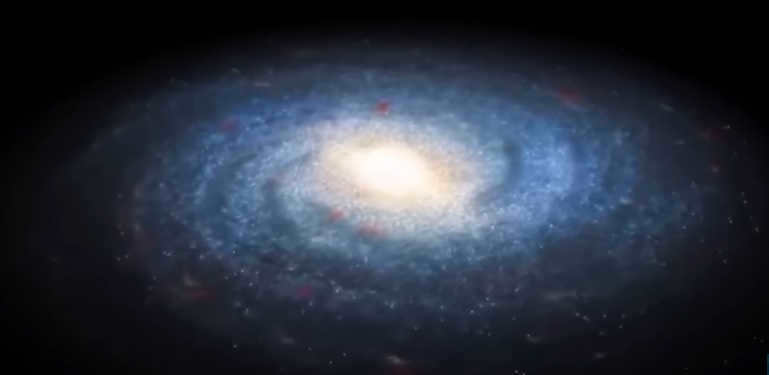
The issue at hand is the measurement of velocity using a narrow spectrometer, with velocity being estimated once again through the Doppler effect. However, when observing the arms of this galaxy, it becomes apparent that the light is passing through dense regions of gas. Consequently, this gas is likely to cause a shift in the spectrum, making it difficult to trust the accuracy of such changes. These conditions introduce an unknown error in the instrument, causing the spectrometer to display not the relative velocity, but an unknown value. It is worth noting that I have not come across any studies examining the impact of the gas environment on the redshift of the spectrum.
How did the idea originate that photons remain unchanged as they traverse the universe? That’s pure nonsense! The universe does not contain a true vacuum, but rather a highly diluted gas composed of molecules and charged particles (ionized). Consequently, photons of light inevitably interact with these entities and consequently lose energy.
If we can ignore this interaction at small distances, then we must consider it at distances of billions of light years. However, how can we do that? After all, there are no experiments on the aging of photons. There is simply a blind belief, similar to the belief in an expanding universe, that there is no aging. And so, these individuals also believe that the redshift is only possible due to the Doppler effect. They discuss the Big Bang as a done deal, rather than a hypothesis. They claim that there is a lot of evidence for this theory. However, if refutations were rewarded, there would be significantly more evidence against the Big Bang than there is for it.
Why does the redshift increase as distance increases?
What kind of radiation do we receive from distant objects in the Universe? Definitely from massive stars, and the further they are, the more massive they need to be for us to detect it. Nothing comes from small objects at those distances. Especially if they have traveled billions of light years. That’s why the redshift is so significant. And it continuously changes as the photons travel. This is a very rough explanation because luminosity depends not only on the mass of stars but also on many other factors.
Is it possible to accurately measure the rate of galaxy dispersion in a universe filled with massive clusters of matter?
In order to achieve this, one must counteract the influence of gravity and other variables. I am unsure of how to accomplish this task as gravity is pervasive. The prevailing belief is that it is impossible to do so. On the contrary, we can estimate the mass of the radiation source based on this shift, while assuming that there is no scattering whatsoever. It wouldn’t be surprising if, when considering the effects of gravity, it is discovered that there is no scattering in the universe at all. The universe appears to be nearly uniform on a large scale.
Another idea suggests that only exceptionally bright light reaches us from a specific distance.
It is highly probable that there exists a similar concept to the Heisenberg uncertainty principle. If this concept applies to each wavelength, then it becomes impossible for us to detect photons with energies lower than the minimum detectable energy. Consequently, this energy is associated with a specific distance from the source, such as 15 billion light years. This distance sets a limit on the observable universe’s size within a given frequency of light or a specific range of the electromagnetic spectrum. As we approach this limit, our ability to detect light will be restricted to extremely luminous stars with significant masses and significant redshifts. In the case of X-rays, this limit will be larger but still present.
The Challenges of Measuring Distance to an Object
Astronomers rely on cepheids, which are stars that vary in brightness, to determine the distance to faraway objects. The period of pulsation of these stars is directly linked to their luminosity. By accurately determining the luminosity, scientists can calculate the distance to the star with an error margin of 15-20%. However, Hubble encountered a significant error of 300% when measuring the distance to the Andromeda Nebula. This error occurred because he was unaware of the existence of two different types of true cepheids with distinct luminosities. If additional types of cepheids are discovered, the margin of error could increase further.
An additional challenge in measuring vast distances is accounting for the time it takes for light to travel. Over the course of billions of years, the object being observed has moved even farther away. This means that when calculating distance based on luminosity, the resulting value is significantly smaller than the actual distance. In fact, the error can amount to billions of light years. It is likely that scientists now take this into consideration when making distance calculations.
Distance = redshift
There are numerous challenges involved in determining distance accurately. However, the primary hurdle lies in astronomers adopting the measurement of distance to distant objects based on redshift. This decision seems rather irrational. They have chosen to assume that the Big Bang theory is unquestionable. Consequently, they have to believe that light cannot interact with anything along its path and that redshift is solely connected to the Doppler effect. This assumption is as firm as the latest decree of the Central Committee of the Communist Party of the Soviet Union. Moreover, contemporary astronomers acknowledge the Syunyaev-Zel’dovich effect to account for the unevenness of relic radiation, while simultaneously disregarding the phenomenon of redshift alteration itself when traversing an ionized medium and electron gas.
Recent findings from the Webb telescope fail to support the hypothesis of universal expansion
1. The James Webb Telescope (JWST) has provided fresh data indicating an unprecedented redshift in certain galaxies, surpassing previous records and suggesting an origin dating back 250 million years earlier.
2. Contrary to expectations based on the Big Bang theory, these new images reveal that distant galaxies exhibit similar sizes to those in close proximity, and spiral galaxies maintain a consistent, regular shape.
3. The question of the origin of new matter and energy within an expanding universe remains unanswered. Current explanations are inadequate and defy the laws of conservation of energy, a notion that remains unchallenged by all but astronomers.
4. What causes the expansion to accelerate? When we find a repulsive force that is stronger than gravity at cosmic distances, we can discuss the theory of expansion. Besides temperature, we have no knowledge of any repulsive or scattering factor in matter.
5. However, the main issue with the Big Bang (BB) is the asymmetry of baryonic matter, which remains unexplained. Why are there more particles in the universe than antiparticles? In other words, why is all matter made up of particles? Without the BZ theory, we can assume that antiparticles only exist in gas pedals.
What is the reason behind physicists’ endorsement of the notion that our universe is expanding?
An understandable query emerges. Why do numerous brilliant individuals continue to uphold the misconception that the universe is expanding? Why don’t they reject this absurdity?
Where should those dedicated to studying the universe’s expansion direct their efforts?
Primarily, where should scientists with their research papers, theses, and prestigious positions turn to? What purpose do they serve, and why are they compensated?
And what is the solution to the problem of storing all their findings and pseudo-discoveries? Everything is being wasted. Entire research institutions have been dedicated to explaining a non-existent expansion. Should all these individuals be fired, their positions abolished, and their titles revoked? It is unlikely that anyone will take such drastic measures in the near future.
What exactly are matter and field?
Physicists have already made significant progress in uncovering the nature of elementary particles. So, what comes next? What areas still require their attention?
Despite the progress made, there is still much to explore. For instance, we still lack a complete understanding of the electron. Its appearance, structure, and true nature remain a mystery. We only have knowledge of some of its properties, such as charge, mass, spin, and interaction cross section. We have yet to determine the mass of the neutrino.
The second paradox lies in Einstein’s demonstration that mass is, essentially, energy in his famous equation.
However, a photon, which possesses energy, lacks mass. Therefore, there appears to be an issue either with the formula or with the physical model. Some individuals even attempt to determine the rest mass of a photon using this formula. Meanwhile, others assert that the formula is not applicable to entities with zero mass. But why is this the case? Could it be because we lack knowledge about the true nature of a photon? Why does it possess a singular frequency? Is the amplitude of its waves constant? How many oscillations does it contain? When an electron transitions to a different level, why does it emit a long multi-period wave rather than a single period? Or perhaps a photon is composed of just a single period? It may simply be that the other photons within the light beam are coherent, making it impossible for us to detect a single photon. In fact, we do not possess a fundamental physical understanding of what an electromagnetic wave truly is, why it propagates in a specific direction, and why it diverges as a result of diffraction.
We lack understanding of the functioning of the atom. Unless we take into account Rutherford’s simplistic and unquestioning model, which proposes electrons revolving around the nucleus. However, the perplexing aspect is that they do not release electromagnetic waves. Moreover, there is an enigmatic reason behind their movement in specific orbits at particular energy levels.
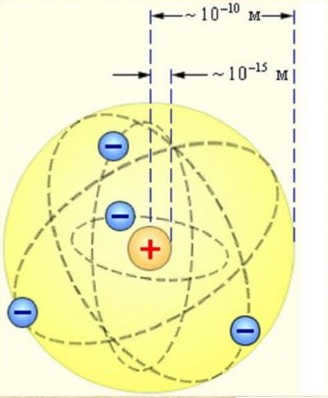
However, it appears that the true nature of matter will remain a mystery for a considerable period, as the subject matter is exceedingly intricate. Fortunately, the outdated Rutherford model has been discarded in contemporary physics. At the very least, the notion of orbitals is no longer discussed.
Yet, an even more captivating query, for which we currently lack an answer, pertains to the essence of a field. Whether it be electric, magnetic, gravitational, or otherwise, what is its inherent structure and physical representation? Why and how do particles interact through a vacuum, assuming such a vacuum exists? Furthermore, how does a variable magnetic field give rise to an electric field, and vice versa?
For instance, a novel hypothesis posits that the occurrence of the big bang does not require any form of energy. Rather, it originates from a fluctuation akin to the Heisenberg uncertainty principle, albeit on a cosmic scale. In this scenario, energy emerges from the vacuum and subsequently dissipates into infinity. This fluctuation serves as the birthplace of the entire universe, an astounding revelation that would undoubtedly merit a Nobel Prize for the creation of a perpetual motion machine. Remarkably, no energy is necessary for this process; instead, we can power it solely with fluctuations and draw upon the infinite reserves of energy. It may seem impersonal, but it is merely a mathematical concept. Yet, without the guiding principles of physics, math remains devoid of substance and often leads to nonsensical outcomes.
Life appears to be improving. Remarkably, this notion holds significant practical implications in terms of finance and employment.
Unanswered queries
It would be preferable if fellow scientists would dedicate their time to addressing the following queries:
- How accurate is Newton’s law of universal gravitation when applied to immense masses, forces, and distances? Is it necessary to modify it, as the theory of relativity suggests?
- What is the origin of the matter or energy in the universe? Explanations involving fluctuations are not satisfactory.
- Why is there such a significant concentration of matter or energy in the universe?
- Why does the total charge of the universe amount to zero?
- Why does the balance of microparticles (electrons, protons, neutrinos, quarks, etc.) remain constant? Or does it fluctuate?
- How do particles transition into one another, such as radiation transforming into an elementary particle and vice versa?
Understanding the Singularity Phenomenon
Those who support the Big Bang theory often refer to the concept of a Singularity. However, a precise definition of this term remains elusive. It is said to represent a moment when all the matter in the universe was condensed into a single point with infinite density, causing the concept of time to cease. In my view, proponents of the Singularity use it as a way to conceal their lack of understanding. If time truly ceased to exist, why would it suddenly reappear?
Interestingly, there is no definitive definition of time, space, or mass. As a result, all equations, including those formulated by Einstein, are merely hypothetical. They attempt to link together variables that are still unknown to us and likely interconnected.
Conclusions
If our universe is indeed expanding, it is likely not happening at the speed and acceleration that has been interpreted from the redshift. Instead, it is probably occurring at much smaller values. It is possible that the theory of expansion has arisen from inaccurate measurement methods.
There may exist dark matter and energy, but not as a result of a rapid expansion with acceleration. It is conceivable that the “anomalous” motion of matter in spiral galaxies is actually due to incorrect measurements of total mass, and that the expansion of galaxies is a result of inaccurate measurements of velocity and mass. In order to move forward, it is crucial to ensure the accuracy of our measurements before indulging in speculation.
To learn more, please visit:
Add this page to your bookmarks by pressing ctrl+D
There is a belief that the world may not possess eternal existence due to its lack of stability. Furthermore, everything constantly undergoes changes, accelerates, and progresses towards some destination. This notion is met with skepticism by certain individuals, who raise valid inquiries. What precisely are these questions? Let’s explore a few examples:
1. What is the rate of expansion of the universe?
The rate of expansion of the Universe has been measured by scientists and found to be 73.8 km/sec/mega-parsec. But what does this number mean?
Scientists have discovered that the Universe is not only expanding, but it is also expanding at an increasing rate. By using the brightness of stars to make calculations, scientists have determined the precise value of the acceleration of the Universe as it expands.
The universe is expanding at a rate of 73.8 kilometers per second for every 3.26 million light-years, with a margin of error of 2.4 kilometers.
As we gaze deeper into the vast expanse of the Cosmos, we witness the ever-increasing velocity at which distant galaxies and clusters recede from our position. This remarkable phenomenon was initially noted by Edwin Hubble in 1929 and subsequently became known as Hubble’s Law, which governs the expansive nature of our Universe. Utilizing cutting-edge observational instruments, we can now corroborate the accuracy of this fundamental law across billions of light-years in every conceivable direction.
2. Is it possible for the universe to expand at a speed greater than that of light?
The limitation of the speed of light only applies to objects that are moving in relation to each other within the same location in space.
Based on Hubble’s Law, the rate at which the Universe is expanding is not constant. Some galaxies are moving away from us at a speed of 1000 km/s, while others that are twice as far away are moving at a speed of 2000 km/s, and so on. Therefore, Hubble’s law suggests that beyond a certain distance known as the Hubble distance, galaxies are moving away from us at a velocity that exceeds the speed of light. Taking into account the currently measured value of the Hubble constant, this distance is estimated to be approximately 14 billion light years.
However, doesn’t Einstein’s personal theory of relativity state that no physical object can travel faster than the speed of light? The answer to this question is actually quite simple. The truth is that the specific theory of relativity only applies to the movement of matter within space, not to the expansion of space itself.
On the other hand, Hubble’s law pertains to the velocity caused by the expansion of space, not the motion within it. This phenomenon, governed by the general theory of relativity, does not adhere to the personal theory of relativity. The fact that galaxies are moving away from each other at speeds exceeding that of light does not violate the personal theory of relativity in any way. Therefore, it remains true that no one and nothing can surpass the speed of light.
3. What is the reason for the expansion of the universe?
Scientists have accurately measured the rate of expansion of the universe, which is 73.8 km/sec/mega-parsec.
The fact that we can measure the rate of expansion of space provides further evidence that the universe is indeed expanding. Some theorists suggest that the observed expansion is merely an illusion caused by our galaxy’s position in a vast empty space. However, the precise data on the rate of expansion of the universe has disproven this “void theory.” Now, scientists are focused on understanding the factors driving the expansion of the universe.
This is the term coined by scientists to describe the enigmatic power responsible for the expansion of the Universe, defying the pull of gravity. Additionally, scientists have deduced that the stars and galaxies visible to us account for a mere 5% of the observable Universe’s makeup. The majority, 68%, is composed of an enigmatic force known as dark energy. Unlocking the secrets of this elusive force of repulsion remains a coveted objective for astrophysicists.
However, dark energy does not always prevail. In regions where ordinary matter is densely concentrated, localized gravitational effects take precedence. This is why not all galaxies are moving away from the Milky Way. For instance, our closest neighbor in the local group, the Andromeda galaxy, is hurtling towards us at a velocity of 80 km/s and is set to collide with our Milky Way Galaxy in four billion years.
There is no specific location where a room is filled with objects.
To comprehend this concept, let’s explore the principles of the general theory of relativity regarding space and time.
According to general relativity, the fundamental characteristics of the space-time continuum are the distance and time interval between two points. In essence, it is the distance that defines the concept of space. As time progresses, the distance between galaxies expands. However, it is not the galaxies themselves moving apart from each other; rather, it is the expansion of space itself surrounding us.
The continuous increase in distance between galaxies can occur without the galaxies actually undergoing physical movement. We observe the Doppler shift in distant galaxies (known as “redshift”) and infer motion.
However, when observing the universe on a cosmological scale, we notice that the scale of space has significantly increased after distant galaxies have emitted light and it has reached us. This expansion of space leads to an increase in the wavelength of photons, resulting in a phenomenon known as “redshift”.
Interestingly, the farther galaxies are from us, the faster they appear to be moving away from us. This might suggest that these galaxies are moving at speeds exceeding the speed of light. However, the reality is that it is not the galaxies themselves moving faster than the speed of light, but rather the expansion of the universe itself. In this scenario, galaxies can remain stationary while the universe expands at an accelerated pace.
Essentially, the fact that galaxies are moving away from us faster than the speed of light implies that certain parts of the universe are so distant that the light emitted from those regions will never reach us. Currently, these unreachable regions are located approximately 46.1 billion light years away from us.
Consequently, any entity surpassing 4.5 gigaparsecs (14-15 billion light years) in distance will forever remain inaccessible to us. All these entities, comprising 97% of the observable Universe, lie beyond our grasp. Even a ray of light originating from such a distant location will forever elude us.
The Universe is not undergoing expansion, but rather experiencing an increase in mass.
According to theoretical astrophysicist Christoph Wetterich, the expansion of the Universe is merely a misconception. Instead, what is actually happening is a gradual growth in the total mass of all particles within the Universe.
The phenomenon of “redshift” is often interpreted as evidence of mass moving away from us, leading scientists to conclude that the Universe is expanding. However, Wetterich, based at Heidelberg University in Germany, presents a different perspective. He argues that the characteristics of light emitted by atoms are also influenced by the mass of their constituent particles, particularly electrons. Since the speed of light is limited, when we observe distant galaxies, we are essentially observing them as they appeared in the past when the light we detect was emitted.
However, if all masses were once smaller and consistently growing, the radiation emitted by ancient galaxies would be shifted towards the red end of the spectrum. The magnitude of this red shift would be directly proportional to the distance between the galaxies and Earth. As a result, it appears to us that galaxies are moving away from each other, when in reality, there is no such movement. Instead, the Universe is simply expanding and becoming larger.
What are your thoughts on this revelation? It certainly presents a different perspective on the nature of the universe.
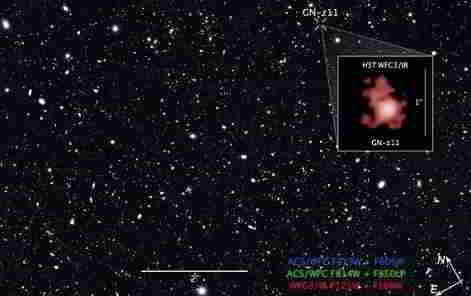
Scientists have observed the most distant galaxy from Earth, known as GN-z11, using the Hubble telescope. Located in the constellation of the Big Dipper, this galaxy is approximately 13.4 billion light-years away and is comprised of extremely hot blue stars. Its radius measures around 2,000 light years, which is 25 times smaller than our Milky Way galaxy.
It has been determined that GN-z11 came into existence 400 million years after the Big Bang, when the age of our Universe was just 3% of its current age.
Since the speed at which a galaxy moves away from us is directly proportional to its distance from Earth, it can be concluded that GN-z11 is moving away from us at the fastest speed possible in the Universe.
The previous record holder, galaxy UDFj-39546284, formed approximately 430 million years after the Big Bang and is situated 13.37 billion light-years away from Earth.
With the occurrence of the Big Bang approximately 13.8 billion years ago, the birth of the galaxy GN-z11 took place during the early stages of the Universe’s evolution. The remarkable discovery of this incredibly luminous galaxy at such an immense distance from Earth raises doubts about the current understanding of how the Universe was formed.
Specifically, the observation of early galaxies holds significant importance as it allows for crucial adjustments to be made to the timeline of the Universe. This is due to the fact that shortly after the Big Bang, the Universe was enveloped in a “fog” comprised of neutral hydrogen atoms that did not emit any radiation.
When the stars illuminated, their UV light ionized this haze, bringing an end to the “dark ages” and allowing the Universe to become observable. Recent estimates suggest that ionization began approximately 530-550 million years after the Big Bang. However, the discovery of galaxies like GN-z11 indicates that this process may have commenced earlier, or progressed at varying rates in different regions of the Universe.
The most distant objects are also characterized by redshift. However, photometric redshifts can be misleading. The previous record holder for the “farthest galaxy” had a photometric redshift of 11.9. Yet subsequent measurements have raised doubts about this finding: it is possible that the galaxy is actually much closer to Earth than initially believed.
The galaxy GN-z11 is located in the Big Dipper constellation with equatorial coordinates of 12h 36m 25.46s 62° 14′ 31.40″ [1]. With a redshift of z = 11.1, light from this galaxy has been traveling for 13.4 billion years, meaning it was emitted 400 million years after the Big Bang [1]. Due to the expanding universe, the distance to the GN-z11 galaxy is approximately 32 billion light years. The galaxy has an escape velocity (radial velocity) of about 295,000 km/s, which is more than 0.98 times the speed of light. In terms of star mass, the GN-z11 galaxy is 100 times smaller than the Milky Way. The rate of star formation in GN-z11 is estimated to be 20 times higher than the current rate in the Milky Way.
However, experts are of the opinion that the veteran of space exploration has already reached its technological limits, and the successor to the “Hubble” will be responsible for exploring the farthest corners of the universe.
This new telescope, known as “James Webb”, will be specifically designed to detect infrared electromagnetic radiation. It is believed that this spectrum will allow scientists to potentially observe the light emitted by the earliest stars in the universe. These stars are likely to be located approximately 200 million light years beyond GN-z11. The study of these first stars and the conditions in which they formed is of great interest to scientists. It is highly likely that these stars were colossal and formed from the cold, inert gases that were prevalent in the cosmos at that time.
The existence of these colossal beings was marked by brilliance, albeit of limited duration, during which they synthesized the initial heavy elements. Moreover, they were compelled to energize the unreactive gases in their vicinity by extracting electrons from constituent atoms, thereby giving rise to a diffuse plasma that persists in the surrounding interstellar space to this very day.
A mere century in the past, the scientific community unveiled the astonishing revelation that our vast cosmos is undergoing an accelerated expansion.
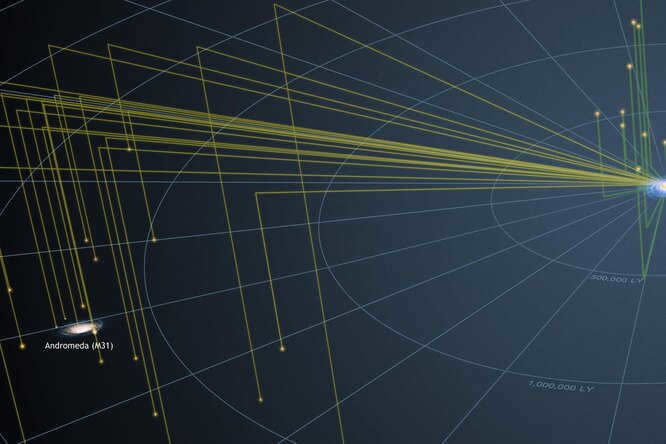
In 1870, a brilliant English mathematician named William Clifford proposed a groundbreaking concept: the possibility of a curved space that could vary in curvature over time. He even speculated that these changes could be linked to the movement of matter. Remarkably, these ideas would later become fundamental to Albert Einstein’s general theory of relativity. Tragically, Clifford passed away from tuberculosis at the young age of 34, just 11 days before Einstein was born.
Redshift
Astrospectrography was the first method to provide information about the expansion of the Universe. In 1886, the English astronomer William Huggins observed that the wavelengths of starlight are slightly shifted compared to the Earth’s spectra of the same elements. By using the formula for the optical version of the Doppler effect, which was derived in 1848 by the French physicist Arman Fizeau, it is possible to calculate the magnitude of a star’s radial velocity. These observations enable the tracking of the movement of cosmic objects.
In 1917, a set of information regarding the radial velocities of 25 nebulae was released by him. This data revealed a noticeable lack of symmetry in the directions of these celestial objects. Out of the 25 nebulae, only four were observed to be moving towards the Sun, while the rest were observed to be moving away, with some even displaying rapid motion.
Slifer did not actively pursue recognition or promote his findings, resulting in their limited exposure within the field of astronomy. It was not until the renowned British astrophysicist Arthur Eddington took notice of these findings that they began to gain recognition within the astronomical community.
In 1924, he released a monograph discussing the concept of relativity, which featured a compilation of 41 nebulae’s radial velocities as discovered by Slifer. Among these nebulae, four of them exhibited a blue shift, while the remaining 37 showed red-shifted spectral lines. The range of their radial velocities spanned from 150 to 1800 km/s, which was on average 25 times higher than the established velocities of stars within the Milky Way at that time. This finding suggested that nebulae were engaged in motions beyond the conventional movements of celestial bodies.
Space islands
During the early 1920s, the prevailing belief among astronomers was that the spiral nebulae existed on the outskirts of the Milky Way, with nothing but vast empty space beyond. It is true that in the 18th century, a few scientists speculated that the nebulae might be enormous star clusters (referred to as “island universes” by Immanuel Kant). However, this hypothesis did not gain widespread acceptance due to the lack of a reliable method for determining the distance to the nebulae.
Edwin Hubble, who operated the 100-inch reflector telescope at the Mount Wilson Observatory in California, was the one who resolved this issue. In 1923-1924, he stumbled upon the fact that the Andromeda Nebula is comprised of numerous luminous entities, including variable stars belonging to the Cepheid group. During that time, it was already established that the period of change in their apparent brightness is connected to their absolute brightness, making Cepheids ideal for measuring cosmic distances. Hubble utilized them to calculate that Andromeda is situated approximately 285,000 parsecs away (modern data suggests it to be 800,000 parsecs). The estimation for the Milky Way’s diameter at that time was around 100,000 parsecs (in reality it is three times smaller). Consequently, it was deduced that Andromeda and the Milky Way should be perceived as autonomous star clusters. Shortly after, Hubble identified two more autonomous galaxies, which ultimately validated the “island universes” theory.
By 1926, Hubble had conducted a statistical analysis of observations made on four hundred “extragalactic nebulae” (a term used to describe them for a significant period of time, in order to avoid referring to them as galaxies), and put forth an equation to establish a relationship between the distance to a nebula and its apparent brightness. Despite the considerable inaccuracies associated with this methodology, the newly acquired data provided further confirmation that the nebulae are distributed relatively evenly throughout space and extend well beyond the boundaries of the Milky Way. There was now no longer any uncertainty regarding the fact that the cosmos extends beyond our Galaxy and its immediate neighboring celestial bodies.
Space Modelers
Eddington’s interest in Slifer’s findings arose even before the true nature of spiral nebulae was fully understood. At that time, there was already a cosmological model that somewhat predicted the effect later revealed by Slifer. Eddington extensively pondered over this concept and, naturally, seized the opportunity to validate the cosmological significance of the observations made by the Arizona astronomer.
The inception of modern theoretical cosmology can be traced back to 1917, when two groundbreaking articles were published proposing universe models based on the general theory of relativity. One article was authored by Einstein himself, while the other was written by the Dutch astronomer Willem de Sitter.
